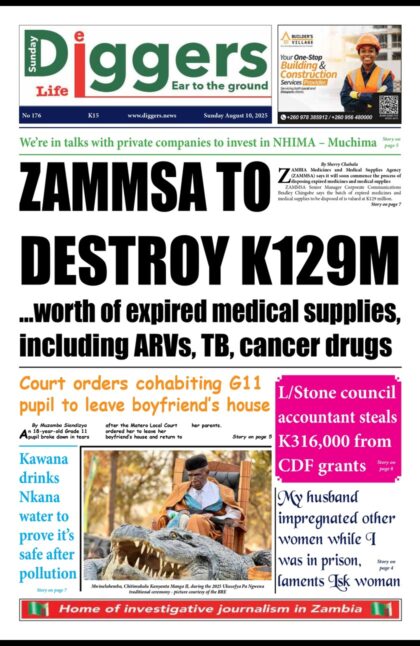Barclays Bank UK says China is unlikely to give the Zambian government comprehensive debt relief as there is little incentive to do so.
And Barclays Bank UK says Zambia could default on some of its debt obligations by next year if the current trajectory of excessive debt accumulation is sustained, while the country equally risks a balance of payments crisis.
Meanwhile, the kwacha’s outlook remains weak for the rest of 2019 on account of government’s continued excessive debt servicing repayments and dwindling international gross reserves, data shows.
In a comprehensive, analytical research report availed by Barclays Bank UK dubbed: “Zambia’s ‘end game’ – a scenario analysis,” China is unlikely to ease Zambia’s debt burden.
“In early 2018, the government said it was seeking a re-profiling of its debts with China in order to provide liquidity relief. But despite several trips to China by high-ranking Zambian delegations, no deal has been forthcoming, with the Minister of Finance (Margaret Mwanakatwe) telling investors in April that the discussion with China focused on a reduction in interest rates rather than a re-profiling, e.g., an extension of maturities,” stated the report, which was compiled by Emerging Market analysts Rita Babihuga-Nsanze and Andreas Kolbe.
“We think the likelihood of China unilaterally providing comprehensive debt relief to Zambia is low. Unlike other SSA countries (e.g., Angola, Republic of Congo, Ethiopia), Zambia is important neither strategically nor from a natural resource perspective. It has copper assets, but these belong to private international mining companies and are not a resource the government can exchange for support. And with China’s share of the debt accounting for only c.30 per cent of the total, there is little incentive for it to bail out the sovereign, only for it to continue servicing the debt of other creditors. In fact, there is no precedent for China single-handedly bailing out an African country that was on the brink of default.”
Zambia’s external debt has continued climbing to US $10.18 billion as at last month from US $10.05 billion by the end of last year, while the foreign reserves position has continued dropping to about US $1.46 billion by February, 2019, from US $1.56 billion by the end of last year.
The country’s external debt profile reveals that China and the sovereign Eurobond jointly-account for 63 per cent of debt servicing repayments alone as at end of 2018, according to Ministry of Finance data.
And the analysts cited government’s sustained rise of debt accumulation, compounded by little foreign exchange inflows, as major factors leading to a possible scenario of debt default, while an urgent International Monetary Fund (IMF) bailout programme still remained elusive.
“Zambia’s debt repayment capacity has been significantly eroded in recent years. While a debt restructuring is not yet unavoidable, in our view, on the current trajectory the country appears on a path to default and a balance of payments crisis,” the research report, released last week, stated.
“The current domestic political climate points, in our view, to a continuation of the lax policies that have characterized the Zambian policy-making environment in recent years. We think such policies—including the lack of radical fiscal adjustment, contracting of external debt at a rapid pace and a willingness to run down international reserve buffers below safe levels—have confounded investors and contributed to a perception that the country is headed for a hard stop.”
The report observed that government’s draconian move to seize Konkola Copper Mines Plc’s assets and place it under provisional liquidation last month will further compound Zambia’s already-constrained liquidity position.
“Tensions with the country’s main foreign currency generating sector, mining, have recently escalated. The government has initiated a process to terminate the operating licence of Vedanta Resources’ subsidiary Konkola Copper Mines (KCM), in which the government owns a 20.6 per cent minority stake. The timing of the government’s action is curious. Given its financing difficulties, the action could suggest an even more strained cash position than we previously thought,” read the report.
“Based on the financing constraint, it is difficult to see a feasible scenario in which Zambia muddles through beyond mid-2020, and, indeed, until the elections in 2021. Doing so would require selective default or rearranging some of the debt service payments on a unilateral basis, in our view, and in a way that might not be entirely transparent to the market.”
Other crucial factors raising the prospect of a default by next year are the likelihood of emergency power imports required to plug Zambia’s power deficit following power utility Zesco’s resumed load shedding.
“All in all, we project Zambia’s 2019 gross external financing needs, i.e. external debt service plus the projected current account deficit, will exceed the starting level of reserves, with the country now at an elevated risk of a balance of payments crisis. Any potential additional shock to the balance of payments position, such as having to import emergency electricity on account of a domestic power deficit, would run reserves down faster and accelerate the impending sudden stop (i.e. the point at which the country is no longer able to service its external debts) or lower-than-expected copper prices,” it stated.
Meanwhile, data showed that the kwacha’s outlook remains weak for the rest of this year on account of government’s continued excessive debt servicing repayments and dwindling international gross reserves.
“At its peak, the kwacha reached K13.96/USD on 20 May, but it has since reverted after the Bank of Zambia’s decision to raise rates by 50bps on 22 May. The outlook for the currency remains weak, challenged by the low level of reserves and elevated debt service payments for the rest of 2019,” it stated.
























